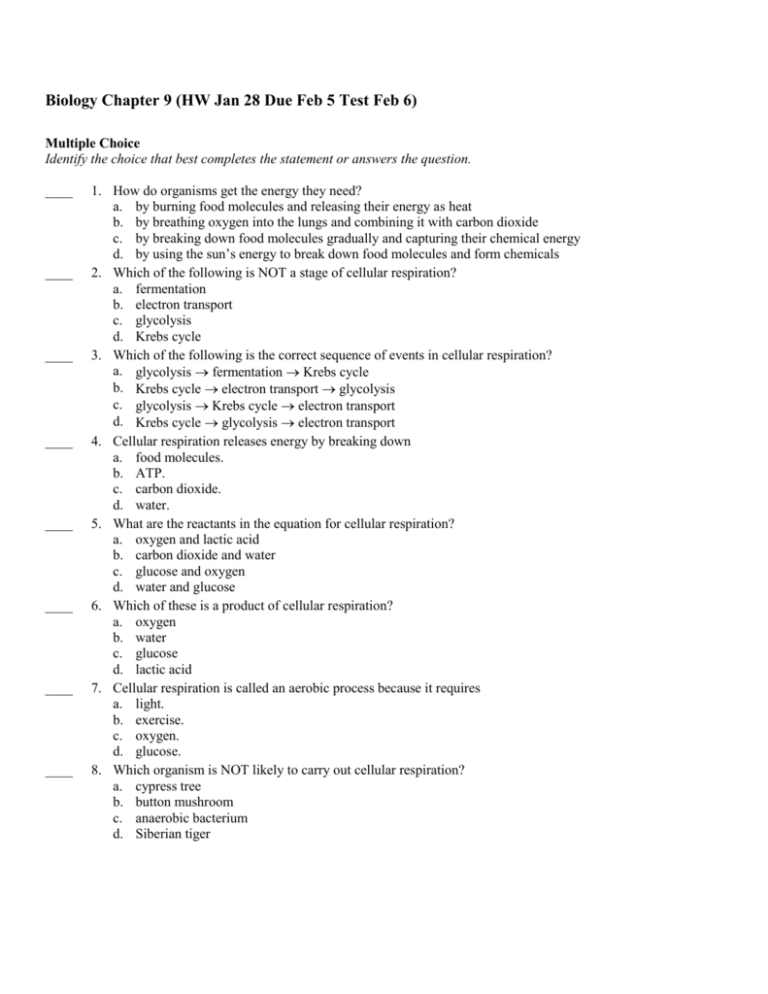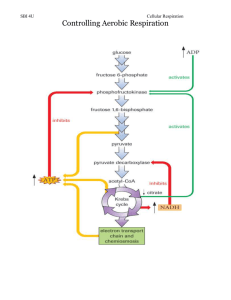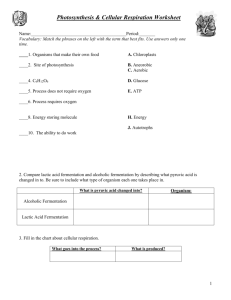Biology Chapter 9 - Barnstable Academy
advertisement

Biology Chapter 9 (HW Jan 28 Due Feb 5 Test Feb 6) Multiple Choice Identify the choice that best completes the statement or answers the question. ____ ____ ____ ____ ____ ____ ____ ____ 1. How do organisms get the energy they need? a. by burning food molecules and releasing their energy as heat b. by breathing oxygen into the lungs and combining it with carbon dioxide c. by breaking down food molecules gradually and capturing their chemical energy d. by using the sun’s energy to break down food molecules and form chemicals 2. Which of the following is NOT a stage of cellular respiration? a. fermentation b. electron transport c. glycolysis d. Krebs cycle 3. Which of the following is the correct sequence of events in cellular respiration? a. glycolysis fermentation Krebs cycle b. Krebs cycle electron transport glycolysis c. glycolysis Krebs cycle electron transport d. Krebs cycle glycolysis electron transport 4. Cellular respiration releases energy by breaking down a. food molecules. b. ATP. c. carbon dioxide. d. water. 5. What are the reactants in the equation for cellular respiration? a. oxygen and lactic acid b. carbon dioxide and water c. glucose and oxygen d. water and glucose 6. Which of these is a product of cellular respiration? a. oxygen b. water c. glucose d. lactic acid 7. Cellular respiration is called an aerobic process because it requires a. light. b. exercise. c. oxygen. d. glucose. 8. Which organism is NOT likely to carry out cellular respiration? a. cypress tree b. button mushroom c. anaerobic bacterium d. Siberian tiger Figure 9–1 ____ 9. Using Figure 9–1, which pairing matches the structures shown in the cell diagrams with the processes that take place within those structures? ____ 10. ____ 11. ____ 12. ____ 13. ____ 14. ____ 15. a. A: photosynthesis; B: cellular respiration b. C: photosynthesis; D: cellular respiration c. D: photosynthesis; E: cellular respiration d. E: photosynthesis; D: cellular respiration Which process does NOT release energy from glucose? a. glycolysis b. photosynthesis c. fermentation d. cellular respiration Which of the following is one of the ways that cellular respiration and photosynthesis are opposite processes? a. Photosynthesis releases energy, and cellular respiration stores energy. b. Photosynthesis removes carbon dioxide from the atmosphere, and cellular respiration puts it back. c. Photosynthesis removes oxygen from the atmosphere, and cellular respiration puts it back. d. Photosynthesis consumes glucose, and cellular respiration produces glucose. Photosynthesis is to chloroplasts as cellular respiration is to a. chloroplasts. b. cytoplasm. c. mitochondria. d. nuclei. Plants cannot release energy from glucose using a. glycolysis. b. photosynthesis. c. the Krebs cycle. d. cellular respiration. The products of photosynthesis are the a. products of cellular respiration. b. reactants of cellular respiration. c. products of glycolysis. d. reactants of fermentation. Which of these processes takes place in the cytoplasm of a cell? a. glycolysis b. electron transport c. Krebs cycle d. photosynthesis ____ 16. Glycolysis provides a cell with a net gain of a. 2 ATP molecules. b. 4 ATP molecules. c. 18 ATP molecules. d. 36 ATP molecules. ____ 17. The starting molecule for glycolysis is a. ADP. b. pyruvic acid. c. citric acid. d. glucose. ____ 18. Glycolysis requires a. ATP. b. oxygen. c. sunlight. d. NADP+. ____ 19. Which of the following is NOT a product of glycolysis? a. NADH b. pyruvic acid c. ATP d. glucose ____ 20. Which of the following is an electron carrier that plays a role in cellular respiration? a. NAD+ b. pyruvic acid c. NADP+ d. ATP ____ 21. The starting molecule for the Krebs cycle is a. glucose. b. NADH. c. pyruvic acid. d. coenzyme A. ____ 22. The Krebs cycle does NOT occur if a. oxygen is present. b. oxygen is not present. c. glycolysis occurs. d. carbon dioxide is present. ____ 23. The Krebs cycle produces a. oxygen. b. lactic acid. c. carbon dioxide. d. glucose. ____ 24. The Krebs cycle starts with a. lactic acid and yields carbon dioxide. b. glucose and yields ATP. c. pyruvic acid and yields lactic acid. d. pyruvic acid and yields carbon dioxide. ____ 25. In the presence of oxygen, glycolysis is followed by a. lactic acid fermentation. b. alcoholic fermentation. c. photosynthesis. d. the Krebs cycle. Figure 9–2 ____ 26. What process do the arrows for oxygen going in and water coming out represent in the Figure 9–2 diagram of the mitochondria? ____ 27. ____ 28. ____ 29. ____ 30. a. electron transport b. fermentation c. glycolysis d. the Krebs cycle In eukaryotes, electron transport occurs in the a. inner mitochondrial membrane. b. nucleus. c. cell membrane. d. cytoplasm. Which of the following pass high-energy electrons to the electron transport chain? a. NADH and FADH2 b. ATP and ADP c. citric acid d. acetyl–CoA The energy of the electrons passing along the electron transport chain is directly used to a. make lactic acid. b. make citric acid. c. transport H+ ions. d. split water molecules. Lactic acid fermentation occurs in a. bread dough. b. any environment containing oxygen. c. muscle cells. d. mitochondria. ____ 31. The two main types of fermentation are called a. alcoholic and aerobic. b. aerobic and anaerobic. c. alcoholic and lactic acid. d. lactic acid and anaerobic. ____ 32. The air bubbles and spongy texture of bread are due to which process? a. lactic acid fermentation b. glycolysis c. alcoholic fermentation d. the Krebs cycle ____ 33. When microorganisms in milk produce acid under certain conditions, yogurt results. Which of these processes would you expect to be key in the production of yogurt? a. the Krebs cycle b. photosynthesis c. alcoholic fermentation d. lactic acid fermentation ____ 34. During fermentation, a. NAD+ is regenerated, allowing glycolysis to continue. b. glucose is split into 3 pyruvic acid molecules. c. oxygen is required. d. carbon dioxide is produced. ____ 35. The conversion of pyruvic acid into lactic acid requires a. alcohol. b. oxygen. c. ATP. d. NADH. ____ 36. Breathing heavily after running a race is your body’s way of a. making more citric acid. b. repaying an oxygen debt. c. restarting glycolysis. d. stopping the electron transport chain. ____ 37. When the body needs to exercise for longer than 90 seconds, it generates ATP by carrying out a. lactic acid fermentation. b. alcoholic fermentation. c. cellular respiration. d. glycolysis. ____ 38. If you want to control your weight, how long should you exercise aerobically each time that you exercise? a. at least 90 seconds b. less than 15 minutes c. 15 to 20 minutes d. more than 20 minutes ____ 39. Which statement mainly explains why even well-conditioned athletes have to pace themselves for athletic events that last several hours? a. Lactic acid fermentation can cause muscle soreness. b. Heavy breathing is needed to get rid of lactic acid. c. Cellular respiration releases energy more slowly than fermentation does. d. Alcoholic fermentation produces carbon dioxide. ____ 40. All of the following are sources of energy for humans during exercise EXCEPT a. stored ATP. b. alcoholic fermentation. c. lactic acid fermentation. d. cellular respiration. Modified True/False Indicate whether the statement is true or false. If false, change the identified word or phrase to make the statement true. ____ 41. A Calorie is the amount of energy needed to raise the temperature of 1 gram of water 1 degree Celsius. _________________________ ____ 42. Cellular respiration releases energy by breaking down glucose in the presence of carbon dioxide. _________________________ ____ 43. Either cellular respiration or fermentation can be used to release energy, depending on the presence of carbohydrates. _________________________ Figure 9–3 ____ 44. All but one of the organisms listed in the food chain in Figure 9–3 carry out cellular respiration. _________________________ ____ 45. The net products of glycolysis are 2 ATP, 2 NADH, and 2 pyruvic acid molecules. _________________________ ____ 46. The Krebs cycle releases energy in the form of ATP. _________________________ ____ 47. NADH and FADH2 carry electrons from the Krebs cycle to the electron transport chain. _________________________ Figure 9–4 ____ 48. If carbon dioxide is not present, the pathway labeled C in Figure 9–4 usually will not occur. _________________________ ____ 49. The first few seconds of intense exercise use up the cell’s stores of fat. _________________________ ____ 50. During the course of a long race, a person’s muscle cells will use both cellular respiration and lactic acid fermentation to produce ATP. _________________________ Completion Complete each statement. Figure 9–5 51. Figure 9–5 shows that the original source of energy for all organisms in an ocean food chain is ____________________. 52. Glycolysis rearranges a 6-carbon glucose molecule into two 3-carbon molecules of _________________________. 53. Two pyruvic acid molecules going through the Krebs cycle will result in ____________________ ATP molecule(s), as well as the energy carriers FADH2 and NADH. 54. When ____________________ pass through ATP synthase, ATP molecules are produced from ADP molecules. 55. The _____________________________ is a series of carrier proteins that use high-energy electrons to create a buildup of H+ ions on one side of the inner mitochondrial membrane. 56. Glycolysis alone nets only ____________________ molecules of ATP from each glucose molecule. Figure 9–4 57. The pathway labeled B in Figure 9–4 is called ____________________ fermentation. 58. Based on Figure 9–4, ____________________ ATP molecules per glucose molecule are generated through fermentation. 59. In Figure 9–4, only the pathway labeled ____________________ requires oxygen. 60. A person who regularly does aerobic exercise probably takes in ____________________ oxygen than a sedentary person.








